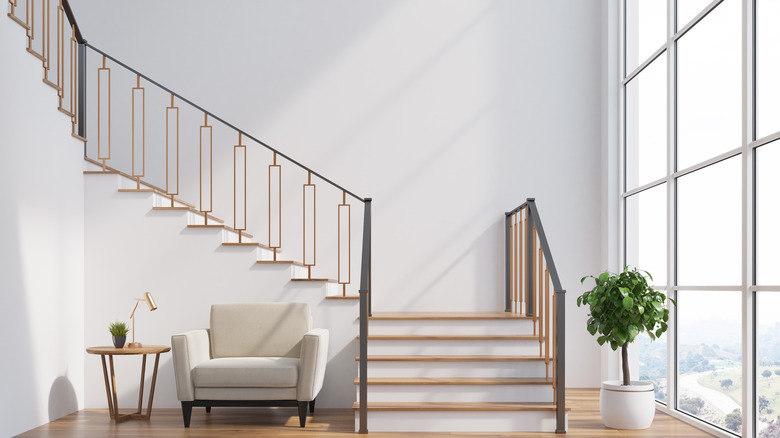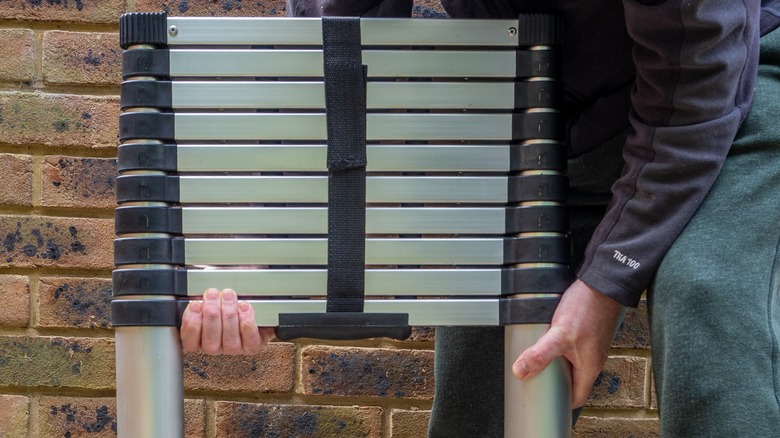The Safest Type Of Ladder To Use When Painting A Stairwell
We may receive a commission on purchases made from links.
Stairwells. It's hard to imagine a trickier space in a house. They're tough to clean, stage, accessorize, decorate ... the list goes on. In fact, if you're fixing up a multi-story home, knowing the safest way to reach high walls when painting your staircase is likely one of your biggest concerns. After all, you can't position a standard ladder on stairs without risking a fall. The alternative, wielding a long-handled paint roller, risks splattering paint all over that recently replaced flooring. The answer: use a double-sided telescoping ladder.
A 2017 study published in Emergency Medicine Australasia (EMA) found that of 177 Australian emergency room patients admitted for ladder falls, most falls were caused by "a combination of user features and flaws in ladder setup." Ladders are a hazard for experienced tradespeople, too. In 2020, across America, there were 22,710 non-fatal workplace injuries resulting in at least one day off work, per the U.S. Bureau of Labor Statistics. A double-sided telescoping ladder ensures you don't become a statistic; you can independently adjust the legs to sit on different height steps while keeping the ladder itself stable and at a safe angle.
Features to look for
Today, most double-sided telescopic ladders (also known as multi-position ladders) are made from aluminum — though occasionally, you'll see fiberglass options. Aluminum is lightweight yet sturdy and rust-resistant, so it should be your material of choice. Also, check that the ladder you're considering meets safety rating requirements. In the U.S., ladders that meet the requirements will be labeled as meeting OSHA 1926.1053 or ANSI A14.2 standards (or both). In Europe and the UK, look for a reference to the safety standard EN131. Other features to look for include a locking mechanism, rung grips, a stabilizer bar, and rubber feet (for extra stability). Optional (read: fancy) features include one-button retraction.
What height and weight limits a ladder needs depends on where and how you want to use it. Telescopic ladders range between 10 and 20 feet in length and carry, on average, between 250 and 330 pounds. Consider your own weight (or that of the person who'll be using the ladder) and how heavy the tools you're using are — in the case of painting a stairwell, tool weight is minimal. Height-wise, a ladder should extend about 3 feet longer than the height of the area you wish to paint. You also never want to stand on the top rung of the ladder, so factor that in when reviewing ladder length.
Using a telescopic ladder
If you're interested in painting your stairwell on a budget or painting a single stairwell one time only, it's probably more cost-effective to hire a ladder. If you have future uses planned for your ladder, it makes sense to invest. Bonus: Telescopic ladders fold down small, so they're easy to stow away in the attic or garage when not in use. You can pick up a 23-foot aluminum multi-position ladder from the trusted brand Little Giant for $449.94 at Walmart. It's rated at 300 pounds. Amazon has another great option for $603.97: a 10-14 foot, OSHA-compliant, wide-step telescoping ladder by Telesteps.
When you're ready to get painting, extend one leg of your multi-position ladder and place it on a stair higher up on the staircase. Next, extend the other leg out and down until it reaches the lowest possible step needed to reach an angle of roughly 75 degrees. This is the side you'll climb and should be much longer than the leg you extended first. Ideally, have someone hold the ladder while you're using it — it's spanning multiple steps, after all. Safety first! Other general safety considerations, per the CDC, include inspecting the ladder for damage before you climb it and following the three-contact points rule. OSHA even has a ladder safety app available for download on iOS and Android phones.

